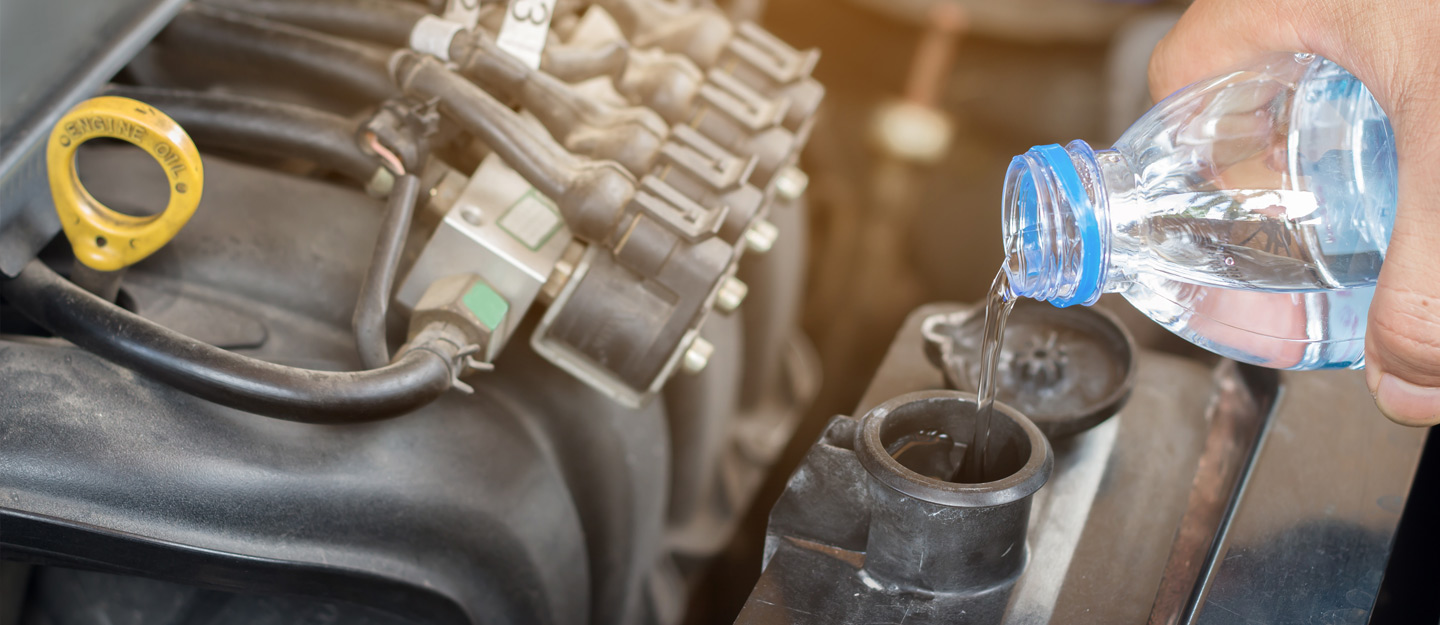Tech
Cooling Essentials: Understanding the Role of Coolant Reservoirs and Engine Oil Coolers

In the intricate world of automotive engineering, engine cooling systems stand as unsung heroes, silently working to maintain optimal temperatures and ensure the smooth operation of vehicles. Within these systems, coolant reservoirs and engine oil coolers play pivotal roles, serving as guardians of engine health and performance. By understanding their functions, maintenance requirements, and troubleshooting techniques, you can gain a deeper knowledge of your vehicle and its needs, empowering you to make informed decisions and ensure its longevity and performance.
Coolant Reservoirs Explained
Coolant reservoirs, often referred to as overflow tanks or expansion tanks, are integral components of a vehicle’s cooling system. To understand their function, imagine a scenario where you’re driving uphill on a hot summer day. As the engine heats up, the coolant expands and is directed into the reservoir via a pressure relief valve. Conversely, as the engine cools down, the coolant contracts, creating a vacuum that draws coolant back into the radiator from the reservoir. This cyclic process ensures that the cooling system remains balanced and that the engine is adequately cooled under varying operating conditions.
Coolant reservoirs operate on a simple yet essential principle. Coolant expands and is directed into the reservoir via a pressure relief valve as the engine heats up during operation. Conversely, as the engine cools down, the coolant contracts, creating a vacuum that draws coolant back into the radiator from the reservoir. This cyclic process ensures that the cooling system remains balanced and that the engine is adequately cooled under varying operating conditions.
Coolant reservoirs are typically constructed from durable plastic materials chosen to resist corrosion and heat. They are often transparent or translucent, allowing for easy visual inspection of coolant levels. Additionally, coolant reservoirs are equipped with markings indicating the minimum and maximum coolant levels, providing drivers with a convenient means of monitoring coolant levels and identifying potential issues.
The Significance of Engine Oil Coolers
Oil coolers are the unsung heroes of engine health, battling the heat generated by engines to preserve their performance. As engines operate, they generate significant amounts of heat, which can cause engine oil to degrade and lose its lubricating properties. Engine oil coolers step in to save the day, helping mitigate this heat buildup by dissipating excess heat and ensuring engine oil remains within the optimal temperature range.
The operation of engine oil coolers is relatively straightforward. They are typically integrated into the engine’s cooling system and connected to the oil filter housing or lines. Engine oil coolers work by using air or liquid as a coolant medium to transfer heat from the engine oil. Air-cooled oil coolers rely on airflow to dissipate heat, while liquid-cooled oil coolers use coolant from the engine’s cooling system to regulate oil temperatures. In simpler terms, they’re like the radiator for your engine oil, helping to keep it cool and prevent it from overheating.
Engine oil coolers have many benefits. By maintaining optimal oil temperatures, they help reduce engine wear and prolong the lifespan of critical engine components. This can help you avoid costly repairs and extend the life of your vehicle. Additionally, they contribute to improved engine performance and fuel efficiency by ensuring that engine oil remains within its ideal operating range. This means your engine can run more smoothly and use less fuel, saving you money in the long run.
Coolant Reservoir Maintenance and Troubleshooting
As a vehicle owner or enthusiast, your role in maintaining the functionality of the engine cooling system is crucial. Regular inspections and maintenance tasks can help prevent coolant leaks, overheating, and system contamination, ensuring the health and performance of your vehicle.
– Checking Coolant Levels: Regularly monitor coolant levels in the reservoir and top up as needed to maintain proper coolant levels. Ensure that coolant levels are within the recommended range indicated on the reservoir.
– Inspecting for Leaks: Periodically inspect the coolant reservoir and associated hoses for signs of leaks or damage. Look for visible coolant stains or puddles beneath the vehicle and address any leaks promptly to prevent coolant loss and overheating.
– Cleaning the Reservoir: Over time, coolant reservoirs can accumulate debris, sediment, and contaminants, which can impede coolant flow and lead to clogs. To clean the reservoir, start by disconnecting the hoses and draining the coolant. Then, use a mild detergent and water solution to remove buildup from the reservoir’s interior. Rinse thoroughly and reassemble the system. This will ensure proper coolant circulation and prevent potential issues.
– Addressing Overheating Issues: If the engine consistently overheats or coolant levels are rapidly decreasing, it may indicate a more significant issue with the cooling system. Ignoring these signs could lead to severe engine damage, costly repairs, or even engine failure. Overheating can cause the engine to seize, which means it stops working and can’t be repaired. In such cases, it is advisable to seek professional diagnosis and repair to identify and address the root cause of the problem.
Engine Oil Cooler Maintenance and Troubleshooting
Maintaining engine oil coolers is critical for ensuring optimal engine performance and longevity. Regular maintenance tasks can help prevent oil contamination, overheating, and component failure.
– Changing Engine Oil Regularly: Regular oil changes are essential for maintaining engine health and ensuring proper lubrication. Clean oil helps optimize engine oil cooler performance by reducing the risk of oil contamination and degradation.
– Checking for Blockages: Inspect the engine oil cooler for any signs of blockages or debris that may impede oil flow and cooling efficiency. Clean the oil cooler as needed to remove any buildup and restore proper functionality.
Monitoring Oil Temperatures: Watch oil temperature gauges or warning lights to detect any abnormalities that may indicate issues with the engine oil cooler. If oil temperatures consistently exceed recommended levels, this may indicate a problem with the cooling system that requires further inspection and repair.
– Addressing Oil Contamination: If engine oil becomes contaminated with coolant or other contaminants, it can lead to engine damage and reduced performance. Address oil contamination issues promptly by flushing the engine oil system and replacing contaminated oil and filters.
Comparing Coolant Reservoirs and Engine Oil Coolers
While coolant reservoirs and engine oil coolers serve distinct purposes within the engine cooling system, they share common goals of maintaining engine health and performance. This section will compare and contrast the two components, highlighting their similarities, differences, and respective roles in the overall engine cooling system.
Similarities:
– Both coolant reservoirs and engine oil coolers are essential components of the engine cooling system, responsible for regulating temperatures and preserving engine health.
– They rely on similar principles of heat exchange and thermal regulation to dissipate excess heat and maintain optimal operating conditions.
Differences:
– Coolant reservoirs primarily store and circulate coolant to regulate engine temperature, while engine oil coolers focus on cooling and maintaining optimal oil temperatures to
Prevent engine wear.
– Coolant reservoirs are typically transparent or translucent and store liquid coolant. At the same time, engine oil coolers are integrated into the engine’s lubrication system and utilize air or liquid as a coolant medium.
Roles:
– Coolant reservoirs prevent engine overheating by storing and circulating coolant throughout the cooling system.
– Engine oil coolers help regulate oil temperatures to prevent oil degradation and ensure proper lubrication, reducing engine wear and extending engine life.
Considerations:
When selecting coolant reservoirs and engine oil coolers for a vehicle, factors such as compatibility, size, and capacity should be considered to ensure proper fitment and functionality. Additionally, it’s a good idea to choose reservoirs and coolers made from durable materials that can withstand the heat and pressure of the engine and regularly check for any signs of wear or damage to ensure they continue to perform effectively.
– Proper maintenance and monitoring of both components are essential for ensuring optimal engine performance and longevity. By keeping your coolant reservoir and engine oil cooler in good condition, you can prevent issues such as engine overheating, oil degradation, and component failure. This can help you avoid costly repairs and extend the lifespan of your vehicle.
Conclusion:
In conclusion, coolant reservoirs and engine oil coolers are indispensable components of the engine cooling system, each playing a unique yet complementary role in maintaining engine health and performance. By understanding their functions, maintenance requirements, and troubleshooting techniques, vehicle owners can ensure that their engines remain adequately cooled and lubricated, prolonging their lifespan and optimizing performance. Regular inspection, maintenance, and proactive troubleshooting are vital to preserving the integrity and functionality of coolant reservoirs and engine oil coolers, ultimately contributing to the overall reliability and longevity of the vehicle.
Tech
Difference Between LED and LCD: Which Display Technology Is Better in 2025?

📺 Introduction
In today’s digital world, choosing the right screen technology can make a big difference in your viewing experience. Whether you’re buying a new TV, monitor, or smartphone, you’ll likely come across two common display types: LED and LCD.
But what exactly is the difference between LED and LCD? And which one should you choose in 2025?
This article breaks it down in simple terms so you can make an informed, tech-savvy decision. We’ll also explore advanced display variations and key considerations to help you choose the right screen for your home, office, or gaming setup.
🔍 What is LCD?
LCD stands for Liquid Crystal Display. It uses liquid crystals sandwiched between two layers of glass or plastic and a backlight to produce images.
How it works:
- Light from a fluorescent lamp (usually CCFL) passes through a polarizing layer.
- Liquid crystals manipulate the light to form images.
- A color filter adds color to the grayscale images formed by the crystals.
Key Features:
- Requires fluorescent backlighting
- Produces images by filtering light through liquid crystals
- Commonly found in budget TVs, monitors, calculators, digital watches
Pros:
- Low production costs
- Good for general use
- Energy efficient compared to older tech like CRT
Cons:
- Weaker contrast and color accuracy
- Slower response times
- Less energy efficient than LED
💡 What is LED?
LED stands for Light Emitting Diode, and LED displays are a subset of LCD technology that uses LED backlights instead of CCFLs.
How it works:
- A panel of white or RGB LEDs emits light behind or on the edge of the LCD panel.
- Provides more precise lighting and dynamic contrast.
Types of LED Displays:
- Edge-Lit LED: LEDs placed along the edges; allows for thinner displays.
- Full-Array LED: LEDs placed evenly behind the panel for better contrast.
- Mini-LED (2025 trend): Uses thousands of tiny LEDs for sharper brightness control.
Pros:
- Slimmer designs
- Higher brightness and contrast
- Greater color accuracy and energy efficiency
- Longer lifespan than standard LCDs
Cons:
- Costlier than LCDs
- Edge-lit models may have uneven lighting
🆚 LED vs LCD: Key Differences
| Feature | LCD | LED |
|---|---|---|
| Backlighting | CCFL (fluorescent) | LED (light-emitting diode) |
| Brightness | Moderate | High |
| Energy Efficiency | Medium | High |
| Color Accuracy | Average | Better |
| Lifespan | Shorter | Longer |
| Viewing Angles | Narrower | Wider (especially IPS LEDs) |
| Cost | Lower | Slightly higher |
Learn more about emerging display technologies and their applications at SpaceCoastDaily.co.uk
📱 Advanced Variants to Consider in 2025
🔹 QLED (Quantum Dot LED)
- Developed by Samsung
- Uses quantum dots to improve color range and brightness
- Better than LED in terms of vibrancy
🔹 OLED (Organic LED)
- Individual pixels emit light (no backlight needed)
- Excellent black levels, contrast, and ultra-slim design
- More expensive, used in high-end TVs and smartphones
🔹 Mini-LED
- Offers better control over dimming zones
- Reduces halo effects and improves dynamic range
- Becoming mainstream in high-end monitors and TVs
These technologies often build upon LED panels, offering better performance at a higher price.
📊 Use Cases: Which One Is Better for You?
📺 For Watching TV
- LED TVs are ideal due to better brightness, energy use, and sleek designs.
- Go for Full-Array LED for optimal movie experience.
💻 For Office Work
- LCD monitors are sufficient for word processing, browsing, and spreadsheets.
- LED provides less eye strain over long periods — recommended.
🎮 For Gaming
- LED monitors with high refresh rates and low response times are superior.
- Avoid basic LCDs due to ghosting and lag.
📱 For Smartphones/Tablets
- LED and OLED dominate the mobile space due to high-quality visuals and efficiency.
🧠 Final Thoughts
While LCD and LED both belong to the same display technology family, LED is significantly superior in most categories that matter to users today — including brightness, energy use, durability, and visual quality.
In 2025, unless you’re shopping on a very tight budget, LED should be your default choice. However, be aware of more advanced options like Mini-LED or OLED if your usage includes creative work, high-end gaming, or home cinema setups.
Looking for more tech comparisons and practical guides? Visit SpaceCoastDaily.co.uk for regularly updated articles and smart recommendations.
❓FAQ: LED vs LCD
Q1: Is LED better than LCD?
Yes. LED is generally better due to its superior brightness, contrast, and energy efficiency.
Q2: Do LED TVs last longer than LCD?
Yes, they tend to have longer lifespans and better reliability.
Q3: Are LED screens more expensive?
Slightly, but they offer better value over time.
Q4: Can I use an LCD monitor for gaming?
Yes, but modern LED monitors are much better suited for gaming due to faster refresh rates.
Q5: Is OLED the same as LED?
No. OLED is a different, more advanced technology that offers individually lit pixels and deeper blacks.
Q6: What is Mini-LED and should I consider it?
Mini-LED is a newer version of LED offering improved contrast and brightness. It’s ideal for professionals and enthusiasts.
Tech
DIY Solar Panel Setup for Home: Save Energy & Money

🌞 Introduction
Want to cut down your electricity bills and reduce your carbon footprint? A DIY solar panel setup for home might be the solution you’re looking for. With solar technology becoming more affordable and efficient, more homeowners are turning to solar power as a long-term investment in sustainability.
In this guide, we’ll break down everything you need to know about setting up a solar panel system yourself—from equipment selection to installation and maintenance. Whether you’re a total beginner or somewhat handy, you’ll walk away ready to go solar, save money, and take control of your home’s energy use.
⚡ Why Choose a DIY Solar Panel Setup for Home?
💰 Cost Savings
One of the biggest advantages of going DIY is saving on labor costs. Hiring professionals can cost thousands, while a DIY setup significantly lowers your total investment.
🌱 Environmental Impact
Solar power is clean and renewable. A typical home system can reduce 3 to 4 tons of carbon emissions annually.
💡 Energy Independence
Producing your own electricity reduces dependence on utility companies and protects you from rising energy prices.
🧰 What You Need for a DIY Solar Panel Setup
Before diving into the installation process, gather these key components:
1. Solar Panels
-
Choose monocrystalline for higher efficiency.
-
Polycrystalline is cheaper but slightly less efficient.
2. Inverter
-
Converts DC (from panels) into AC (for your home).
-
Types: String inverter, microinverters, hybrid inverters.
3. Charge Controller
-
Regulates voltage and current from panels to batteries.
-
Prevents battery overcharging.
4. Battery Bank (Optional but Recommended)
-
Stores excess power for use during night or outages.
-
Lithium-ion batteries are ideal but expensive.
5. Mounting System
-
Roof mounts or ground mounts, based on your space.
-
Ensure they’re durable and weather-resistant.
6. Wiring and Connectors
-
Solar-grade cables (MC4 connectors recommended).
-
Proper fuses and circuit breakers for safety.
7. Net Meter (Optional)
-
For grid-tied systems to earn credit on your power bill.
🛠️ Step-by-Step: How to Install DIY Solar Panels at Home
🔍 Step 1: Assess Your Energy Needs
-
Review your electricity bills (monthly kWh usage).
-
Decide whether to go off-grid, grid-tied, or hybrid.
📐 Step 2: Site Evaluation & Solar Access
-
Use tools like PVWatts or Google Project Sunroof.
-
Ensure your roof gets at least 5-6 hours of direct sunlight daily.
🧮 Step 3: Calculate System Size
-
Average home uses ~900 kWh/month.
-
A 5 kW system (~15-20 panels) usually covers this.
🛒 Step 4: Purchase Equipment
Buy from trusted suppliers with warranty options. For top-tier solutions, check out Circle Solar, a leader in sustainable solar energy solutions.
🔧 Step 5: Install Mounting & Panels
-
Attach the mounting system to your roof or ground.
-
Secure panels onto the racking system.
🔌 Step 6: Connect Electrical Components
-
Wire panels → charge controller → battery bank → inverter → home grid.
-
Ensure all safety disconnects and grounding are in place.
📋 Step 7: Inspection & Activation
-
Get local authority inspection if required.
-
Turn on the system and monitor output via your inverter app or meter.
🔄 Maintenance Tips for Long-Term Efficiency
-
Clean panels 2-3 times a year to remove dust and debris.
-
Check wiring annually for signs of wear or corrosion.
-
Monitor performance with apps or online dashboards.
🧠 Pro Tips for DIY Success
-
Start small: Begin with a portable or single-panel system if you’re new.
-
Take safety seriously: Wear protective gear and follow all electrical codes.
-
Consult your utility provider: Especially for grid-tied systems.
🌐 Real-World Success: Why People Are Going Solar
More and more UK residents are adopting DIY solar power to fight rising energy costs and embrace a sustainable lifestyle. Platforms like Space Coast Daily regularly feature success stories and resources on renewable energy—proving that the solar movement is thriving.
✅ Conclusion: Ready to Harness the Sun?
Installing a DIY solar panel setup for home is not just a trend—it’s a smart investment in your future. With the right tools, planning, and guidance, you can generate your own clean electricity and gain true energy independence.
So, are you ready to start your solar journey? Bookmark this guide, explore Space Coast Daily for the latest in sustainable energy trends, and consider checking out Circle Solar for premium components that last.
❓ FAQ: DIY Solar Panel Setup for Home
Q1: Is it legal to install solar panels myself?
A: Yes, in most regions, DIY installations are legal. However, check your local codes and permit requirements.
Q2: How much does a DIY solar system cost?
A: Expect to spend between £3,000 to £6,000, depending on system size and quality.
Q3: Can I run my entire house on solar?
A: Yes, with a properly sized system and battery backup, you can power your whole home.
Q4: How long do solar panels last?
A: Most panels come with a 25-year warranty and can last even longer with proper care.
Q5: Do I need batteries for my solar system?
A: Batteries are optional but useful for off-grid setups and backup during outages.
Tech
What is Janitor AI? Features, Use Cases & How to Use It Safely in 2025

📝 Introduction
Artificial intelligence is rapidly transforming how we interact online, and Janitor AI is one of the most buzzed-about names in the chatbot space—especially for users looking for customizable, conversational, and even NSFW AI interactions.
Whether you’re exploring it for entertainment, roleplay, or productivity, this guide covers everything you need to know about Janitor AI in 2025—from how it works, its features, limitations, and even the controversy surrounding it. If you’re curious, cautious, or ready to dive in, this is your ultimate reference.
🤖 What is Janitor AI?
Janitor AI is an advanced AI chatbot platform that allows users to interact with a variety of characters—ranging from anime-style bots to customizable virtual personalities. Unlike traditional AI chat tools, Janitor AI focuses heavily on character roleplay, storytelling, and human-like interaction.
Many users have been drawn to the platform due to its allowance (at times) for NSFW (Not Safe For Work) conversations, making it popular among adult users. However, its capabilities extend beyond that.
🔹 Key Features:
-
Character-based AI chats (custom bots)
-
NSFW and SFW modes (optional)
-
GPT-based responses (OpenAI or Kobold API supported)
-
Voice synthesis (in some versions)
-
Public character library
📌 Janitor AI Use Cases in 2025
Despite the controversy, Janitor AI is being used for several legitimate and interesting purposes:
1. Roleplay & Storytelling
Writers and fans use the platform for:
-
World-building
-
Character interaction testing
-
Generating dialogues for scripts and comics
2. Entertainment & Fun
-
Anime fan chats
-
Simulated romantic convos
-
Gaming companion bots
3. Mental Health & Venting
Some users engage with soft-spoken bots to:
-
Simulate therapy
-
Talk out problems
-
Seek non-judgmental conversation
4. Productivity Simulation
-
Practice job interviews
-
Language learning through simulated chats
-
Train customer service interactions
🛠️ How Janitor AI Works
Janitor AI is not powered by its own LLM (Large Language Model). Instead, it connects with external APIs like:
-
OpenAI (ChatGPT) – for safe, filtered interactions
-
KoboldAI or Pygmalion – for unfiltered/NSFW content
-
Local Models (e.g., SillyTavern) – for privacy-focused chats
To use Janitor AI:
-
Sign up and login at [janitorai.com] [EXTERNAL LINK]
-
Choose a character from the public library or create your own.
-
Connect an API key (OpenAI or KoboldAI).
-
Start chatting with the bot of your choice.
⚠️ Note: You must configure API settings correctly. Many users get errors if APIs are not linked.
🚫 NSFW & Content Safety: The Big Debate
One of the reasons Janitor AI became viral is because it allowed NSFW chats, especially using Pygmalion or OpenRouter APIs.
However, this has sparked massive debates online, especially around:
-
AI ethics
-
Age restrictions
-
Content moderation
In 2024-2025, Janitor AI removed direct NSFW support on its main platform, but users still bypass this using external APIs or local installations.
🔒 Tips for Safe Use:
-
Use a local model if privacy is a concern.
-
Never share real personal data.
-
Check if the bot creator has moderation settings enabled.
-
Keep SFW mode on if under 18 or in public/shared devices.
📈 Why Janitor AI is So Popular in 2025
| Reason | Description |
|---|---|
| Customizable Bots | Create your own characters with unique personalities |
| Roleplay Freedom | Many bots simulate romantic or fantasy dialogues |
| Easy to Use | No coding needed, simple UI |
| Cross-Platform | Use in browser, Discord bots, or third-party apps |
| Large Community | Public bots, shared prompts, guides available |
🔄 Janitor AI Alternatives (2025)
If Janitor AI doesn’t suit your needs, here are some trending alternatives:
1. Character.AI
-
Family-friendly
-
No NSFW content
-
Great UI & mobile app
2. Chai App
-
Available on Android & iOS
-
Tons of user-generated bots
-
Less control over filtering
3. Pygmalion AI + SillyTavern
-
Fully unfiltered
-
Requires setup
-
Works offline with local LLMs
4. OpenAI Playground (ChatGPT)
-
Reliable for clean conversations
-
Limited in roleplay compared to Janitor
📌 For a comparison article, see: [Janitor AI vs Character AI – Which is Better?] [INTERNAL LINK]
💻 Developer & Community Tools
If you’re a developer or enthusiast, Janitor AI allows:
-
Bot creation: Customize prompts, memories, behavior.
-
API linking: Choose your preferred backend model.
-
Community uploads: Share your bot with others.
-
Third-party mods: Chrome extensions, Discord integrations
Some devs even run private versions of Janitor AI using open-source tools like:
-
JanitorAI-Local
-
Sillytavern UI
-
KoboldCPP
✅ Pros and Cons
| Pros | Cons |
|---|---|
| Deep roleplay capabilities | May violate ethical/age guidelines |
| Supports multiple AI backends | Complex setup for unfiltered APIs |
| Active community & support | NSFW misuse concerns |
| Free to use (with API) | Not beginner-friendly without guides |
📌 Conclusion (with Links Added)
Janitor AI is much more than just another chatbot it’s a powerful, flexible platform for those looking to dive into immersive conversations with fictional, realistic, or AI-generated characters. Whether you’re writing a fantasy novel, simulating a companion, or just killing time, it opens up countless possibilities.
But with great flexibility comes responsibility. Use Janitor AI ethically, protect your privacy, and respect the boundaries of content guidelines.
Want to explore more ways to leverage AI? Check out our guide on
👉 How to Make Money with ChatGPT in 2025 – 10 Proven Methods
Or visit our homepage for more trending AI tools, tech updates, and tutorials:
🌐 SpaceCoastDaily.co.uk
❓ FAQ – Janitor AI 2025
Q1: Is Janitor AI free to use?
Yes, the platform is free, but you’ll need to connect your own API key (like OpenAI, Kobold, or Pygmalion).
Q2: Is NSFW content still available?
Officially, NSFW content is restricted. However, users can still access it via third-party APIs or local setups.
Q3: Is Janitor AI safe?
It’s generally safe if you use trusted APIs and don’t share personal info. For NSFW use, caution is advised.
Q4: Can I use it without coding?
Yes, Janitor AI has a user-friendly interface. You only need to copy-paste API keys.
Q5: What is the best API for Janitor AI?
For filtered, ethical use: OpenAI. For unfiltered creative freedom: KoboldAI or Pygmalion.
-

 Tech2 weeks ago
Tech2 weeks agoWhat is Janitor AI? Features, Use Cases & How to Use It Safely in 2025
-

 Tech3 weeks ago
Tech3 weeks agoPortalar (PortalAR) Guide 2025: How AR Portals Transform Environments
-

 news2 weeks ago
news2 weeks agoBinomo Scam Exposed: Real Truth Behind the Trading App You Must Know in 2025
-

 news2 weeks ago
news2 weeks agoChatGPT vs Google Gemini: Which AI Wins in 2025?
-

 General3 weeks ago
General3 weeks agoUK Visa Fees 2025: Complete Breakdown for Students, Workers & Tourists
-

 news3 weeks ago
news3 weeks agoJames Webb Telescope News: Exploring the Frontiers of the Universe
-

 Gaming3 weeks ago
Gaming3 weeks agoBest Gaming Accessories Under $50 in 2025 – Ultimate Budget Gaming Upgrades
-

 Fashion3 weeks ago
Fashion3 weeks agoSheer Maxi Dress 2025: The Chic Look Everyone Will Be Wearing







